Content:
- Planting red currants.
- Caring for red currants
- Pruning red currants.
- Formation of red currant bushes.

Planting red currants
When to plant. The best time for planting is the end of September for the middle zone and the first half of October for the southern regions. If planted later, young bushes may not survive the winter well. For successful wintering, plants must take root well, and this takes time.
If it was not possible to plant seedlings in the fall, it is quite possible to do this in the spring - at the end of April. But it must be said that shrubs planted in the fall, with a safe winter, are always ahead in development of plants planted in the spring.
Where to plant. It is recommended to plant currant bushes in open areas that are well lit by the sun. With insufficient lighting, crop productivity decreases. Loose, light loamy, sandy loam soils with a neutral or slightly acidic reaction are well suited for planting red currants.
It is advisable that the planting site be well ventilated, this will significantly reduce the risk of plant diseases from all kinds of fungal diseases.
In general, this is an unpretentious crop; it adapts well to harsh climatic conditions. However, it does not take root in cold, heavily shaded, damp and swampy places.
At what distance to plant seedlings? The largest harvest is obtained when
planting bushes at a distance of about two meters from each other. Then the plants develop freely, without shading, and powerful, healthy bushes grow. Growing on trellises also has a positive effect on yield. If you have chosen the trellis growing method, then you can plant seedlings much more often - every meter.But still leave at least 1.5 m between the rows.
For planting currants, a place is often chosen along a fence or path. You should retreat at least 1 m from the fence and paths. While the seedlings are small, such distances may seem too wasteful, but when the bushes grow, they will take up almost all the free space. However, they will not interfere with each other, and it will be convenient for you to care for them.
Planting pits. To plant, dig a planting hole 40 cm deep and 50 cm wide. Fold the top, fertile soil with which you will cover the roots separately. You need to add a bucket of compost, a glass of superphosphate and a glass of ash to it. If there is no ash, then instead add 40 - 50 g of potassium chloride and mix it all well.
Landing. Before planting, place the bush in a bucket of water for 2 - 3 hours. After this, place the seedling in the planting hole and cover it with the prepared nutrient mixture. Make sure that when planting, the root collar is 5-6 cm below the soil level. With such deep planting, renewal shoots will grow better from the buds located in the root collar area.
When planting, make sure that there are no air bubbles left under the roots. To do this, periodically shake and tug the seedling. After the planting hole is filled in, make an edge around the bush, water it generously and mulch with peat or humus. After this, cut the branches to a length of 15-20 cm, leaving 3-4 buds on each. The first time after planting, you need to water the currants every 3-4 days until they take root.
Caring for red currants
Caring for red currants includes watering, fertilizing, caring for the tree trunk and regular pruning of bushes.If the bush is spreading, then you will have to make stands for the branches.
Tree trunk care
Loosen the soil around the bush regularly and keep it free from weeds. Periodically dig up the periphery of the tree trunk circle. Do this very carefully, the currant roots are not deep and can be easily damaged. Mulch the ground under the bushes with grass clippings, leaves or compost.
Watering
Red currant is a moderately moisture-loving plant. Most of all, regular watering is necessary in the summer, in the heat. The plant will need a lot of moisture after flowering, when the berries begin to fill. To keep the soil in the tree trunk moist for a long time, do not forget about mulching. This simple and not tricky technique significantly reduces the time spent caring for currants. A well-mulched tree trunk does not require weeding or loosening.
Currant feeding
An important element of caring for red currants is feeding. During the growing season, currants consume nutrients in the soil. In order to get good harvests every year, the reserves of these nutrients must be regularly renewed. To do this, it is necessary to give the plants mineral and organic fertilizers several times a year.
- In spring, per 1 m2 of land, add a mixture of 5 kg of compost, 20 g of superphosphate and 25 g of potassium sulfate. In early spring, apply 40-50 g of nitrogen fertilizer.
- In spring, you can fertilize the soil with urea (15 g per 1 m2) or ammonium nitrate (25 g per 1 m2). After the red currants bloom, add 10 liters of liquid mullein or a solution of bird droppings.
- In the fall, fertilize each bush with 100-120 g of superphosphate and 30-40 g of potassium chloride, and then mulch the tree trunk circle with a mixture of peat and rotted manure.
Pruning red currants
Good care of currants involves not only fertilizing and watering, but also proper, timely pruning.
Pruning red currants is somewhat different from pruning its black relative. At the red
fruit buds are formed at the base of annual shoots and on the ringlets. Ringlets are small shoots on old currant branches, only 2 - 4 cm long. Therefore, the harvest is formed not only on young, but also on old branches. That is why anti-aging pruning of red currants has to be done much less frequently than pruning black currants.
A formed, mature bush should consist of 15 - 20 branches of different ages. To do this, after planting the seedling, every year leave 2 - 3 young, strong shoots growing in different directions, and cut off the rest. Red currant shoots bear fruit for 6-8 years, then they need to be replaced.
In adult bushes, cut off broken, drying, old and low-yielding branches. Old branches are always darker, almost black, and are not difficult to identify. For lightening and thinning, branches that grow from the base of the bush are cut out. Annual shoots cannot be pruned, since there are fruit buds on their tops.
Pruning should be done when the plants are dormant, late autumn or early spring. In summer, it is advisable to pinch the tops of green shoots to activate the formation of replacement shoots.
Watch an interesting video about pruning and shaping currant bushes:
Forming bushes on a trellis
Red currants can be easily grown as a trellis crop. Such bushes are easy and convenient to care for, they are well lit by the sun and suffer less disease. When forming such a bush, you need to leave the shoots growing only in one plane, and cut off the rest. Then secure them to 2 - 3 rows of wire, as they do with grapevines.
Bushes with this molding are convenient to place along walls, fences or along paths. Just don’t forget to trim or break out shoots that are not growing in a given plane. In all other respects, care is the same as for ordinary bushes.
Formation of standard currants
Some gardeners form red currants in standard form. Then it becomes like a dwarf tree. The result is an original plant with large berries, which is pleasant and interesting to care for.
To form such a tree, the most powerful shoot that grows vertically is selected from the bush, and all the rest are cut off close to the ground. A trunk is formed from this shoot by cutting off all branches growing below 30 - 50 cm, and the remaining ones are slightly shortened to provoke their branching.
Further pruning resembles caring for a tree; branches growing inside the crown, downwards, and shoots older than seven years are pruned. Of course, you must immediately remove shoots growing from the base of the bush.
Wintering
In winter, care is not at all difficult. Red currant is a winter-hardy crop, but in severe winters with strong winds and sharp temperature fluctuations, the plant's perennial branches may freeze.
If you cover the currants with snow, they will withstand temperatures dropping to -40 - 45 °C. The danger for the plant is spring frosts, during which the flowers and ovary may die.
Care and pest control of fruit bushes without chemicals:
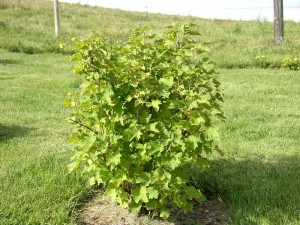
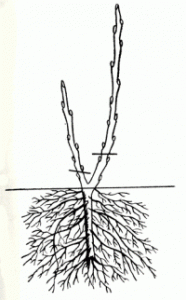
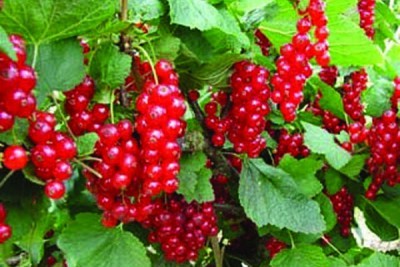
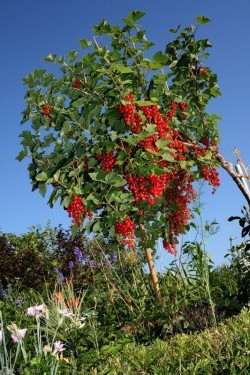
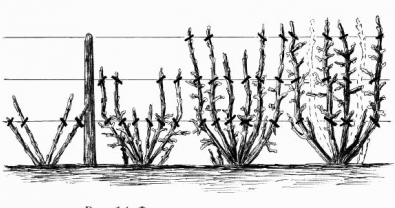
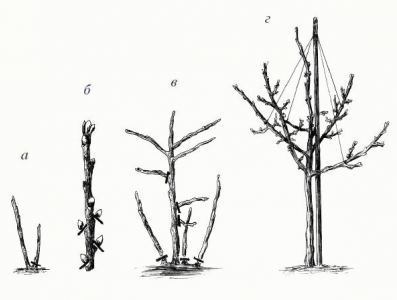

 (4 ratings, average: 4,00 out of 5)
(4 ratings, average: 4,00 out of 5) CUCUMBERS NEVER GET SICK, I'VE BEEN USING ONLY THIS FOR 40 YEARS! I SHARE A SECRET WITH YOU, CUCUMBERS ARE LIKE THE PICTURE!
CUCUMBERS NEVER GET SICK, I'VE BEEN USING ONLY THIS FOR 40 YEARS! I SHARE A SECRET WITH YOU, CUCUMBERS ARE LIKE THE PICTURE! You can dig a bucket of potatoes from each bush. Do you think these are fairy tales? Watch the video
You can dig a bucket of potatoes from each bush. Do you think these are fairy tales? Watch the video
 How our fellow gardeners work in Korea. There is a lot to learn and just fun to watch.
How our fellow gardeners work in Korea. There is a lot to learn and just fun to watch. Eye trainer. The author claims that with daily viewing, vision is restored. They don't charge money for views.
Eye trainer. The author claims that with daily viewing, vision is restored. They don't charge money for views. A 3-ingredient cake recipe in 30 minutes is better than Napoleon. Simple and very tasty.
A 3-ingredient cake recipe in 30 minutes is better than Napoleon. Simple and very tasty. Therapeutic exercises for cervical osteochondrosis. A complete set of exercises.
Therapeutic exercises for cervical osteochondrosis. A complete set of exercises. Which indoor plants match your zodiac sign?
Which indoor plants match your zodiac sign? What about them? Excursion to German dachas.
What about them? Excursion to German dachas.